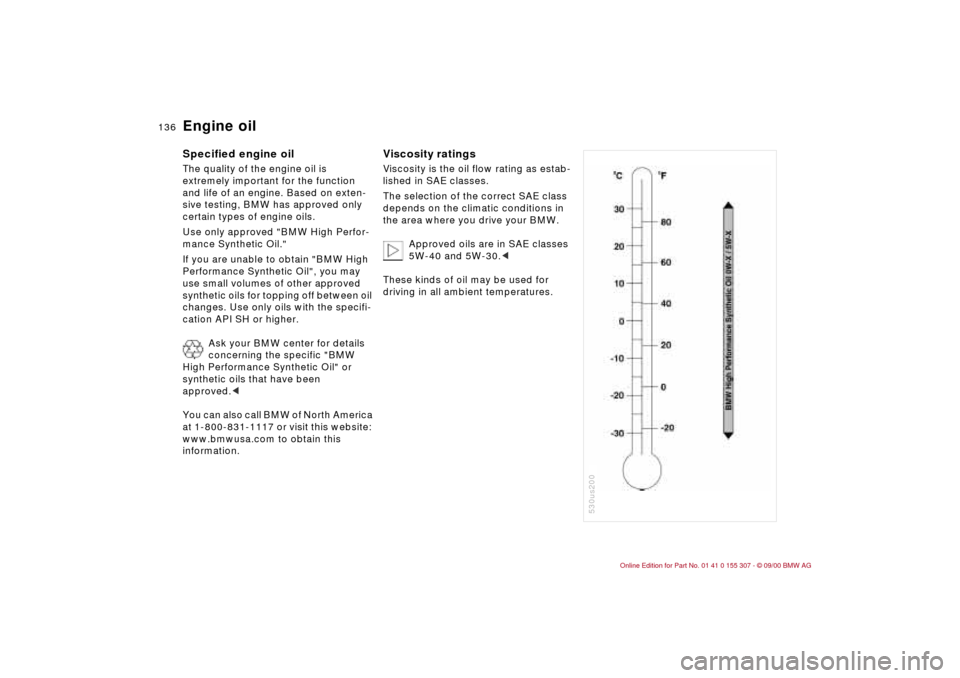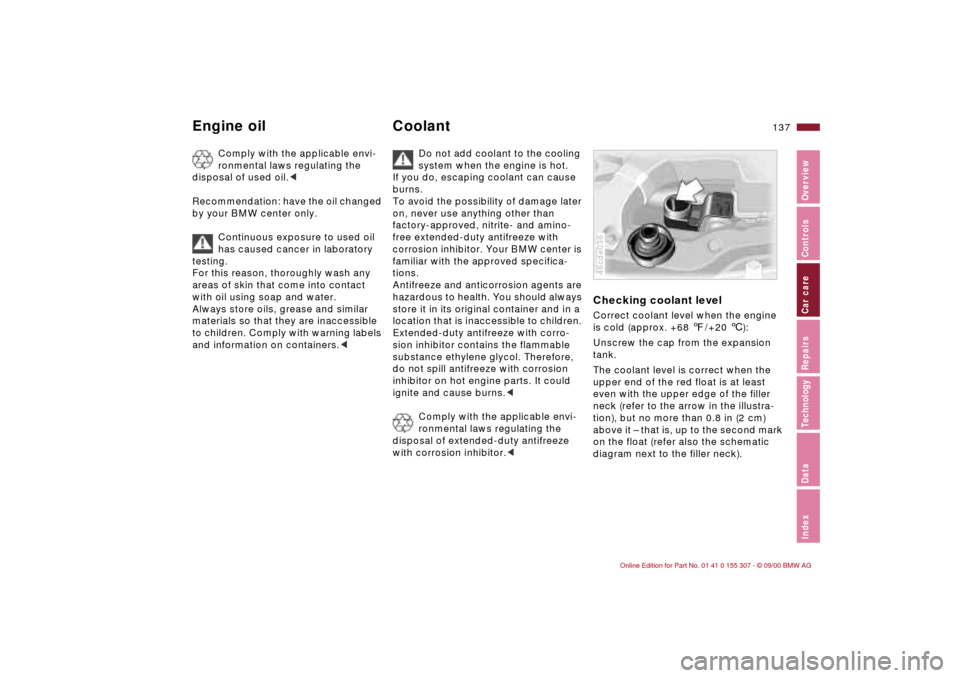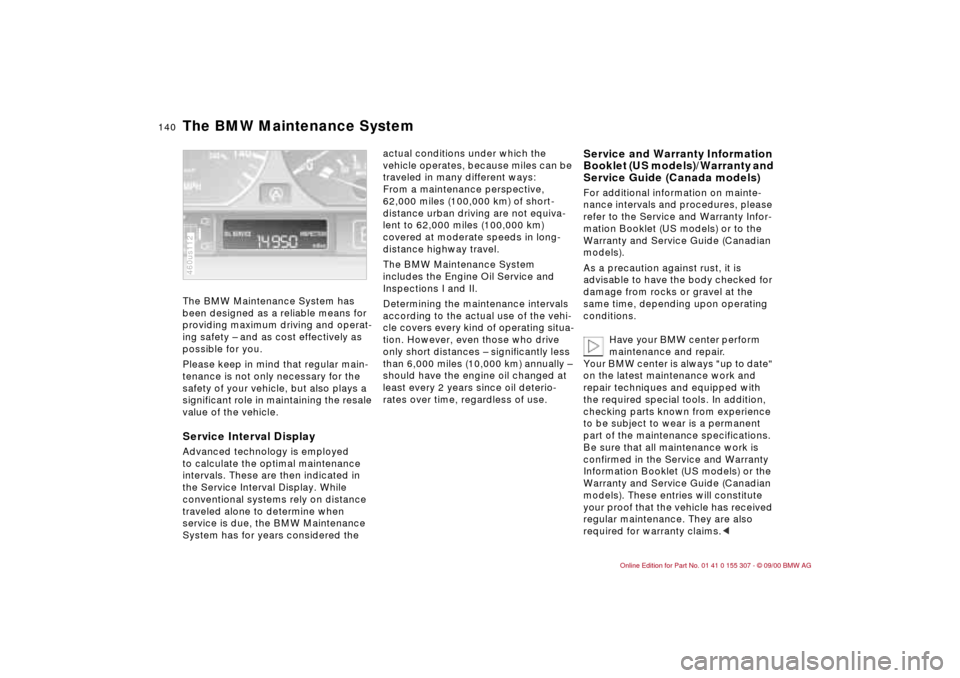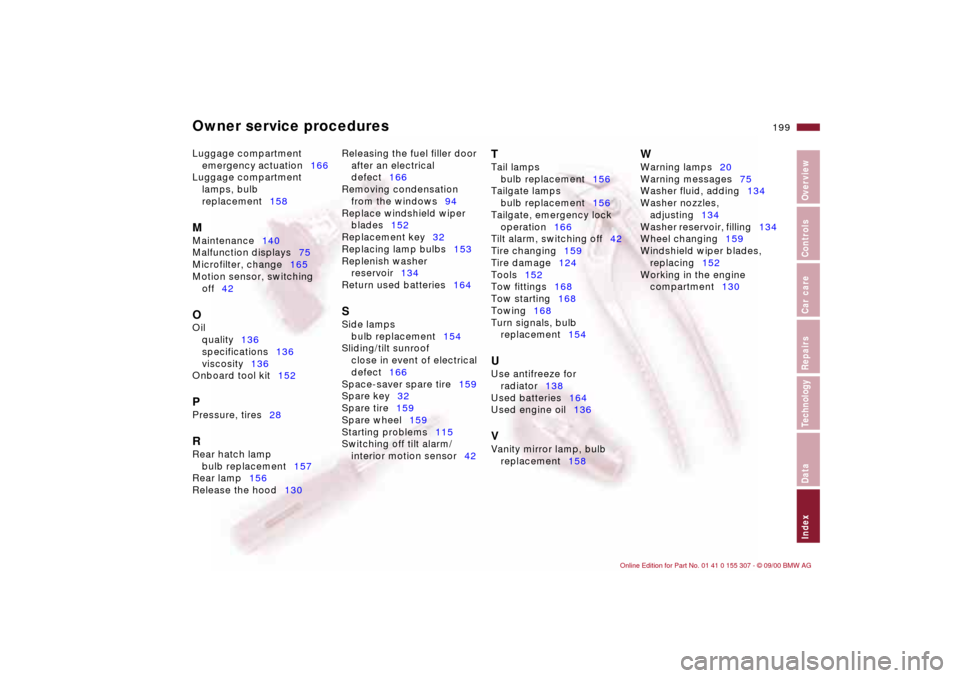2001 BMW 325i TOURING oil change
[x] Cancel search: oil changePage 128 of 203

128n
Winter tiresChoosing the right tireBMW recommends winter tires (M+S
radial tires) for driving in adverse winter
road conditions. So-called all-season
tires with the M+S-identification mark
do indeed possess better winter trac-
tion than summer tires with the load
rating H, V, W, Y und ZR, but usually do
not achieve the same level of perfor-
mance as winter tires.
In the interests of safe tracking and
steering response, install radial tires
made by the same manufacturer and
with the same tread configuration on all
four wheels if you elect to mount winter
tires.
Mount only winter tires which have
been approved by BMW. Any BMW
center will be glad to provide you with
information on the best winter tires for
your particular driving conditions.
Do not exceed specified
maximum speeds
Never exceed the maximum speed
for which the tires are rated.
Unprofessional attempts by laymen to
service tires can lead to damage and
accidents.
Have this work performed by skilled
professionals only. Any BMW center
has the required technical knowledge
and the proper equipment and will be
happy to assist you.<
Tire condition, tire pressureOnce the tire wears to below 0.16 in
(4 mm), winter tires display a percep-
tible decrease in their ability to cope
with winter driving conditions, and
should be replaced in the interest of
safety.
Comply with the specified tire inflation
pressures Ð and be sure to have the
wheel and tire assemblies balanced
every time you change the tires.
StorageAlways store tires in a cool, dry place.
Store them away from light whenever
possible. Protect the tires against
contact with oil, grease and fuel.Snow chains
*
The use of narrow-link BMW snow
chains on summer or winter tires is
approved only in pairs and only on the
rear wheels. Comply with all manufac-
turer's safety precautions when
mounting the chains.
BMW 325xi: in a worst-case scenario,
i.e. if your vehicle is stuck on one side
or you cannot access one tire, then only
one chain may be attached to a rear
wheel for a short period of time.
Comply with all manufacturer's safety
precautions when mounting the chains.
Page 136 of 203

136n
Engine oil Specified engine oilThe quality of the engine oil is
extremely important for the function
and life of an engine. Based on exten-
sive testing, BMW has approved only
certain types of engine oils.
Use only approved "BMW High Perfor-
mance Synthetic Oil."
If you are unable to obtain "BMW High
Performance Synthetic Oil", you may
use small volumes of other approved
synthetic oils for topping off between oil
changes. Use only oils with the specifi-
cation API SH or higher.
Ask your BMW center for details
concerning the specific "BMW
High Performance Synthetic Oil" or
synthetic oils that have been
approved.<
You can also call BMW of North America
at 1-800-831-1117 or visit this website:
www.bmwusa.com to obtain this
information.
Viscosity ratings Viscosity is the oil flow rating as estab-
lished in SAE classes.
The selection of the correct SAE class
depends on the climatic conditions in
the area where you drive your BMW.
Approved oils are in SAE classes
5W-40 and 5W-30.<
These kinds of oil may be used for
driving in all ambient temperatures.
530us200
Page 137 of 203

137n
IndexDataTechnologyRepairsCar careControlsOverview
Engine oil Coolant
Comply with the applicable envi-
ronmental laws regulating the
disposal of used oil.<
Recommendation: have the oil changed
by your BMW center only.
Continuous exposure to used oil
has caused cancer in laboratory
testing.
For this reason, thoroughly wash any
areas of skin that come into contact
with oil using soap and water.
Always store oils, grease and similar
materials so that they are inaccessible
to children. Comply with warning labels
and information on containers.<
Do not add coolant to the cooling
system when the engine is hot.
If you do, escaping coolant can cause
burns.
To avoid the possibility of damage later
on, never use anything other than
factory-approved, nitrite- and amino-
free extended-duty antifreeze with
corrosion inhibitor. Your BMW center is
familiar with the approved specifica-
tions.
Antifreeze and anticorrosion agents are
hazardous to health. You should always
store it in its original container and in a
location that is inaccessible to children.
Extended-duty antifreeze with corro-
sion inhibitor contains the flammable
substance ethylene glycol. Therefore,
do not spill antifreeze with corrosion
inhibitor on hot engine parts. It could
ignite and cause burns.<
Comply with the applicable envi-
ronmental laws regulating the
disposal of extended-duty antifreeze
with corrosion inhibitor.<
Checking coolant levelCorrect coolant level when the engine
is cold (approx. +68 7/+20 6):
Unscrew the cap from the expansion
tank.
The coolant level is correct when the
upper end of the red float is at least
even with the upper edge of the filler
neck (refer to the arrow in the illustra-
tion), but no more than 0.8 in (2 cm)
above it Ð that is, up to the second mark
on the float (refer also the schematic
diagram next to the filler neck).46cde036
Page 140 of 203

140n
The BMW Maintenance System has
been designed as a reliable means for
providing maximum driving and operat-
ing safety Ð and as cost effectively as
possible for you.
Please keep in mind that regular main-
tenance is not only necessary for the
safety of your vehicle, but also plays a
significant role in maintaining the resale
value of the vehicle.
Service Interval DisplayAdvanced technology is employed
to calculate the optimal maintenance
intervals. These are then indicated in
the Service Interval Display. While
conventional systems rely on distance
traveled alone to determine when
service is due, the BMW Maintenance
System has for years considered the 460us112
actual conditions under which the
vehicle operates, because miles can be
traveled in many different ways:
From a maintenance perspective,
62,000 miles (100,000 km) of short-
distance urban driving are not equiva-
lent to 62,000 miles (100,000 km)
covered at moderate speeds in long-
distance highway travel.
The BMW Maintenance System
includes the Engine Oil Service and
Inspections I and II.
Determining the maintenance intervals
according to the actual use of the vehi-
cle covers every kind of operating situa-
tion. However, even those who drive
only short distances Ð significantly less
than 6,000 miles (10,000 km) annually Ð
should have the engine oil changed at
least every 2 years since oil deterio-
rates over time, regardless of use.
Service and Warranty Information
Booklet (US models)/Warranty and
Service Guide (Canada models)For additional information on mainte-
nance intervals and procedures, please
refer to the Service and Warranty Infor-
mation Booklet (US models) or to the
Warranty and Service Guide (Canadian
models).
As a precaution against rust, it is
advisable to have the body checked for
damage from rocks or gravel at the
same time, depending upon operating
conditions.
Have your BMW center perform
maintenance and repair.
Your BMW center is always "up to date"
on the latest maintenance work and
repair techniques and equipped with
the required special tools. In addition,
checking parts known from experience
to be subject to wear is a permanent
part of the maintenance specifications.
Be sure that all maintenance work is
confirmed in the Service and Warranty
Information Booklet (US models) or the
Warranty and Service Guide (Canadian
models). These entries will constitute
your proof that the vehicle has received
regular maintenance. They are also
required for warranty claims.<
The BMW Maintenance System
Page 143 of 203

143n
IndexDataTechnologyRepairsCar careControlsOverview
Caring for your vehicleCaring for the vehicle finish Regular washing is a preventive
measure against long-term effects from
substances that are harmful to the
vehicle's finish, especially if you drive
your vehicle in areas with high levels of
air pollution or aggressive natural
substances (tree resins, pollen).
Nevertheless, you should immediately
remove especially aggressive
substances. Failure to do so can lead to
changes in the paint's chemical
structure or to discoloration. Gasoline
spilled during refueling, oil, grease and
brake fluid should always be cleaned
away immediately, as should bird
droppings.
Any contamination remaining on the
surface of the vehicle will be especially
conspicuous after washing. Use
cleaning fluid or alcohol with a clean
cloth or cotton pad to remove. Remove
tar spots with tar remover. After clean-
ing, the affected areas should be waxed
to ensure continued protection.
Use the cleaning and car-care
products available at your BMW
center.<
Waxing your vehicle Protect the finish using only carnauba
or synthetic-based waxes.
The best way to determine when the
finish needs to be waxed is by noting
when water stops beading on the
surface.
You can use a glass cleaner to remove
any wax or silicone that may have been
left on the windows during waxing.
Use the cleaning and car-care
products available at your BMW
center.<
Paint damageYou can touch up small areas of paint
damage with a BMW spray paint or a
BMW touchup stick.
The paint color code for your car is
provided on a sticker located on the
righthand side under the hood and on
the first page of your Service and
Warranty Information Booklet
(US models) or Warranty and Service
Guide (Canadian models).
Damage caused by flying stones,
scratches, etc., must be touched up
without delay to prevent rust from
forming.
If corrosion has started to form in an
area with paint damage, remove all rust
and clean the area. Then prime the
area with a BMW Primer Stick. Finally,
apply the finish coat. Wait a few days,
then polish the repaired area. Finish by
applying a wax preservative.
More extensive paint damage should
be repaired professionally in accor-
dance with the manufacturer's instruc-
tions. Your BMW center uses original
BMW finish materials in accordance
with approved repair procedures.
Page 187 of 203

187n
IndexDataTechnologyRepairsCar careControlsOverview
Capacities
Notes
Fuel tank
reserve gal. (liters)
gal. (liters)approx. 16.6 (approx. 63)
approx. 2.1 (approx. 8)Fuel specification: page 28
Windshield washer system/
Headlamp washer system (front)
Rear window washer system (rear)quarts (liters)
quarts (liters)approx. 5.6 (approx. 5.3)
approx. 2.4 (approx. 2.3)For details: page 134
Cooling system including heater circuit quarts (liters) approx. 8.9 (approx. 8.4) For details: page 137
Engine oil filter change quarts (liters) 325i approx. 6.9
(approx. 6.5)
325xi: approx. 7.9
(approx. 7.5)BMW High Performance
synthetic oil
Specifications: page 136
Manual and automatic transmission and
differentialÐ Lifetime fluid, no fluid change
required
Page 195 of 203

Everything from A to Z
195n
IndexDataTechnologyRepairsCar careControlsOverview
Luggage
compartment38,107
capacity186
emergency release166
lamps39
lamps, bulb
replacement158
remote control system37
trunk floor40
Luggage compartment lid
emergency release166
Luggage rack111
Lumbar support48 M
Maintenance74
Malfunction displays75
Manual transmission64
Memory49
MFL (Multifunction steering
wheel)24
Microfilter93,165
Mirror memory49
Mirrors51
Mobile phone123
Modifications,
technical6,148
Motion sensor, interior41
Multifunction steering wheel
(MFL)24
M+S tires128
N
Neckrest47
Nozzles96 O
OBD interface socket149
Obstruction protection43
Odometer73
Oil
additives135
capacity187
consumption135
dipstick135
quality136
specifications136
viscosity136
Oil change intervals, refer to
the Service and Warranty
Information Booklet or to
the Warranty and Service
Guide Booklet
Oil filter change187
Oil level, indicator lamp20
Oil pressure, indicator
lamp20
OILSERVICE74
Onboard computer, please
refer to Computer76
Onboard tool kit152
Opening and closing
from the inside38
from the outside34 Opening the rear
window40
Outside temperature
display76
Owner service
procedure141
P
Paint blemishes142
Paintwork
minor repairs143
waxing143
Paint, care142
Park Distance Control
(PDC)78
Parking brake63
Parking help78
Parking lamps88
Parking, winter122
Partition net107
PDC (Park Distance
Control)78
Performance184
Phone, mobile123
Pocket lamp101
Pollen93,100
Power outlet105
Power steering123
Power windows43
safety switch44
Pressure monitoring,
tires85,178
Pressure, tires28,124
Q
Quality Grades125 R
Radiator187
Radio
refer to the separate
Owner's Manual
Radio Data System
(RDS)174
Radio reception123,174
Rain sensor69,177
RDC (Tire Pressure
Control)85,178
RDS (Radio Data
System)174
Reading lamps88
Rear backrest, folded
down108
Rear hatch lamp
bulb replacement157
Rear lamps156
Rear seat backrest,
folding107
Rear window
defroster70,92,99
Rearview mirror51
Recirculated air control92
automatic99
Recirculated-air mode92
Reclining seat46
Refueling27
Page 199 of 203

Owner service procedures
199n
IndexDataTechnologyRepairsCar careControlsOverview
Luggage compartment
emergency actuation166
Luggage compartment
lamps, bulb
replacement158 M
Maintenance140
Malfunction displays75
Microfilter, change165
Motion sensor, switching
off42 O
Oil
quality136
specifications136
viscosity136
Onboard tool kit152 P
Pressure, tires28 R
Rear hatch lamp
bulb replacement157
Rear lamp156
Release the hood130 Releasing the fuel filler door
after an electrical
defect166
Removing condensation
from the windows94
Replace windshield wiper
blades152
Replacement key32
Replacing lamp bulbs153
Replenish washer
reservoir134
Return used batteries164
S
Side lamps
bulb replacement154
Sliding/tilt sunroof
close in event of electrical
defect166
Space-saver spare tire159
Spare key32
Spare tire159
Spare wheel159
Starting problems115
Switching off tilt alarm/
interior motion sensor42
T
Tail lamps
bulb replacement156
Tailgate lamps
bulb replacement156
Tailgate, emergency lock
operation166
Tilt alarm, switching off42
Tire changing159
Tire damage124
Tools152
Tow fittings168
Tow starting168
Towing168
Turn signals, bulb
replacement154 U
Use antifreeze for
radiator138
Used batteries164
Used engine oil136 V
Vanity mirror lamp, bulb
replacement158
W
Warning lamps20
Warning messages75
Washer fluid, adding134
Washer nozzles,
adjusting134
Washer reservoir, filling134
Wheel changing159
Windshield wiper blades,
replacing152
Working in the engine
compartment130